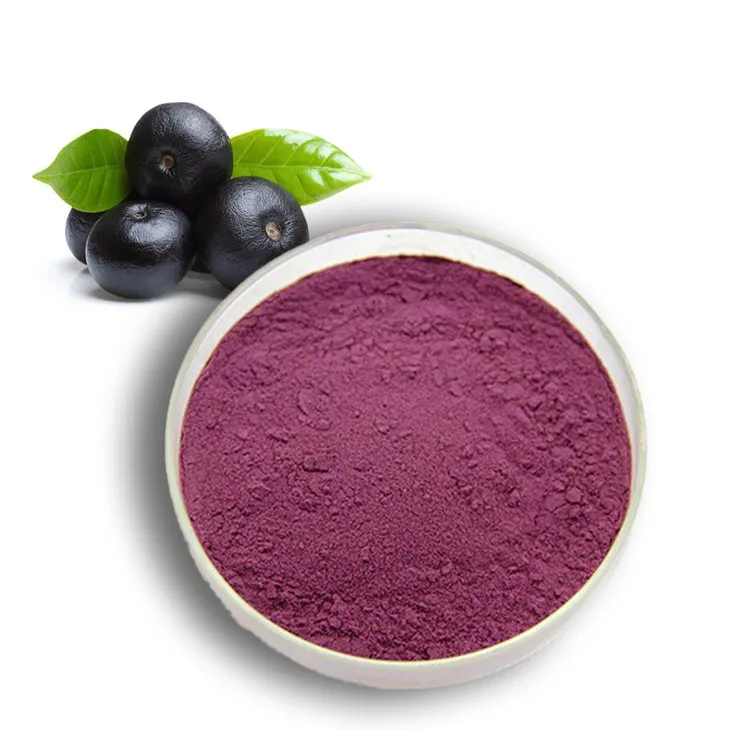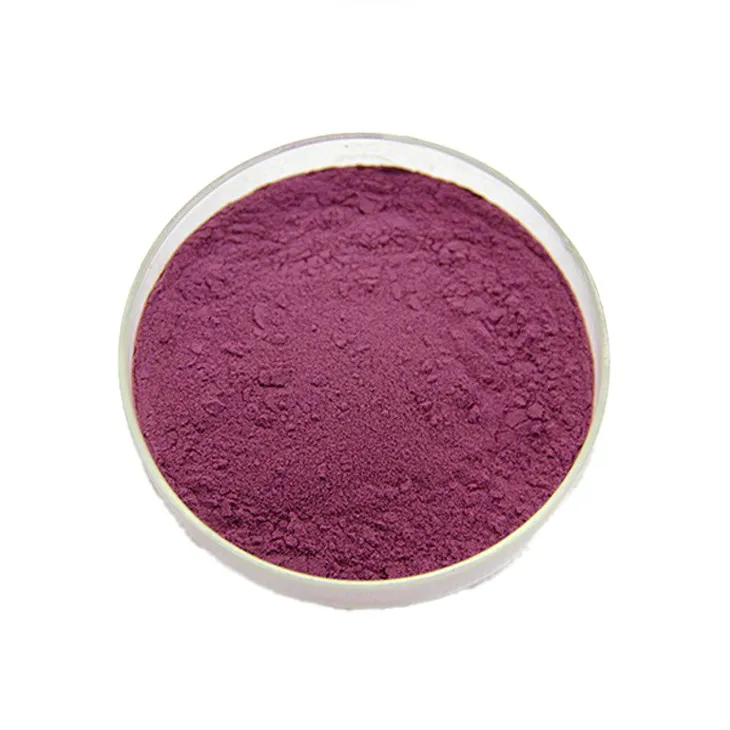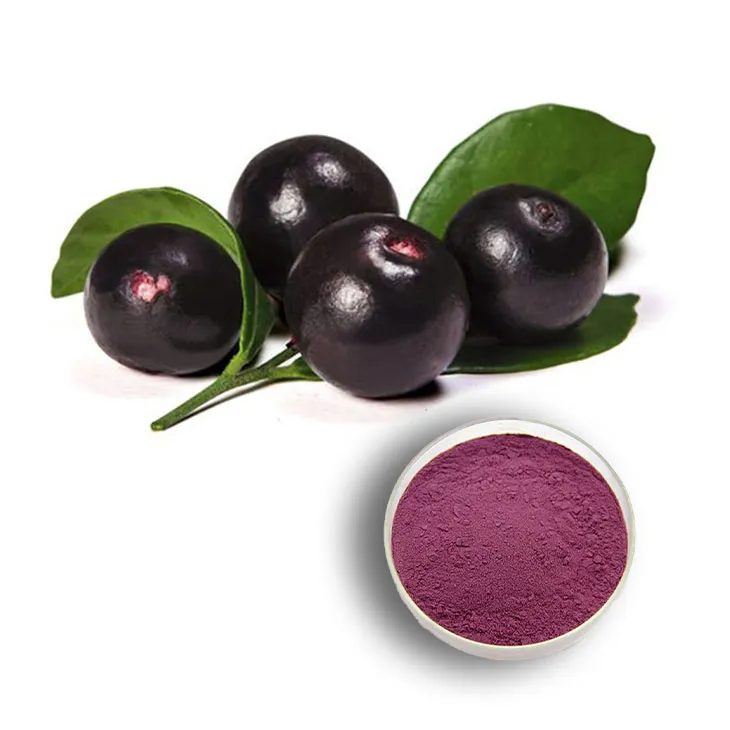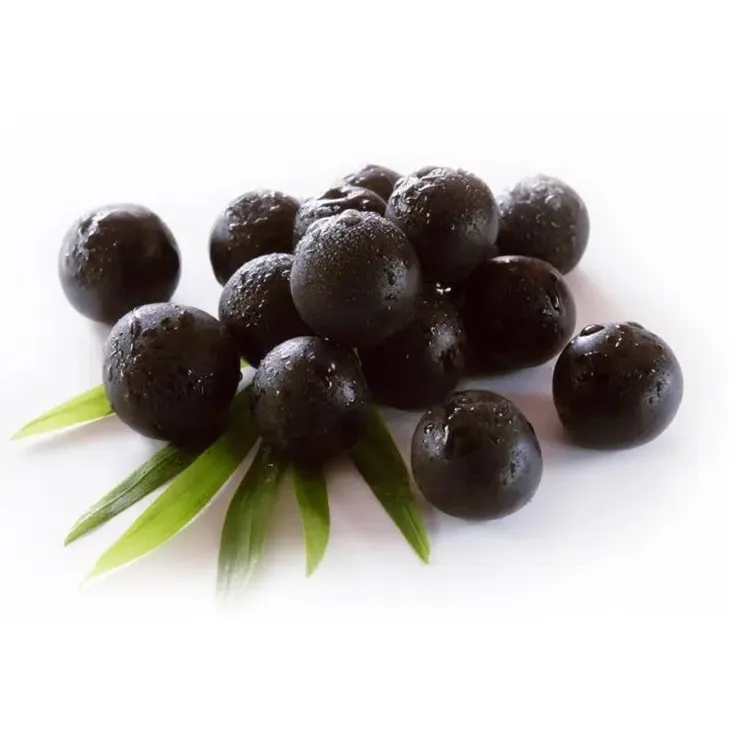- 0086-571-85302990
- sales@greenskybio.com
The process of extracting acai anthocyanins from acai berry extract.
2024-11-30

1. Introduction
Acai berries have gained significant attention in recent years due to their rich content of anthocyanins, which are powerful antioxidants. These anthocyanins are not only beneficial for human health but also have potential applications in the food, pharmaceutical, and cosmetic industries. The extraction of acai anthocyanins from Acai Berry Extract is a crucial process to obtain these valuable compounds in a pure and concentrated form. This article will explore the entire process, starting from the preparation of the Acai Berry Extract to ensuring the quality of the final anthocyanin product.

2. Preparation of Acai Berry Extract
2.1. Harvesting and Selection of Acai Berries
The first step in obtaining acai berry extract is the proper harvesting and selection of the berries. Acai berries are typically harvested from the acai palm tree, which is native to the Amazon rainforest. Harvesting should be done at the right time when the berries are fully ripe to ensure maximum anthocyanin content. Once harvested, the berries need to be carefully selected to remove any damaged or unripe fruits. This initial selection process is important as it can affect the quality of the extract and ultimately the anthocyanin extraction.
2.2. Washing and Cleaning
After selection, the acai berries must be thoroughly washed and cleaned. This step is necessary to remove any dirt, debris, or contaminants that may be present on the surface of the berries. Proper washing techniques should be employed to ensure that the berries are clean without causing any damage to them. For example, gentle agitation in clean water can be used to remove surface impurities. Once washed, the berries are ready for the next step in the extraction process.
2.3. Pulping and Maceration
The washed acai berries are then subjected to pulping and maceration. Pulping involves breaking down the berries into a pulp, which can be achieved using mechanical devices such as blenders or crushers. This process helps to release the internal components of the berries, including the anthocyanins. After pulping, maceration is carried out, which is the soaking of the pulp in a suitable solvent. Commonly used solvents for maceration include water, ethanol, or a combination of both. The maceration process allows the anthocyanins to dissolve into the solvent, creating a crude acai berry extract.

3. Extraction Techniques for Acai Anthocyanins
3.1. Solvent Extraction
- Solvent extraction is one of the most common methods for extracting acai anthocyanins. As mentioned earlier, water and ethanol are popular solvents. Ethanol has the advantage of being a good solvent for anthocyanins and also has antiseptic properties, which can help in preserving the extract. The ratio of solvent to acai berry pulp is an important factor in solvent extraction. A higher solvent - to - pulp ratio generally results in better extraction efficiency, but it also needs to be balanced to avoid excessive dilution of the extract.
- The extraction time also plays a crucial role. Longer extraction times can increase the yield of anthocyanins, but it may also lead to the extraction of other unwanted compounds. Typically, extraction times can range from a few hours to several days, depending on the specific conditions. Temperature is another variable to consider. Moderate temperatures, usually between 20 - 50 °C, are often preferred as higher temperatures can cause degradation of anthocyanins, while lower temperatures may result in slower extraction rates.
3.2. Supercritical Fluid Extraction (SFE)
- Supercritical fluid extraction (SFE) is an emerging and more advanced technique for acai anthocyanin extraction. In this method, supercritical carbon dioxide (CO₂) is often used as the extraction fluid. Supercritical CO₂ has properties similar to both a gas and a liquid, which makes it an excellent solvent for extracting bioactive compounds. It has the advantage of being non - toxic, non - flammable, and can be easily removed from the extract, leaving behind a pure product.
- The process of SFE involves pressurizing CO₂ above its critical point (7.38 MPa and 31.1 °C). The supercritical CO₂ is then passed through the acai berry extract, selectively extracting the anthocyanins. The extraction efficiency of SFE can be optimized by adjusting parameters such as pressure, temperature, and flow rate of the supercritical fluid. However, SFE equipment is relatively expensive, which may limit its widespread use in small - scale extractions.
3.3. Pressurized Liquid Extraction (PLE)
- Pressurized liquid extraction (PLE), also known as accelerated solvent extraction, is another technique that can be used for acai anthocyanin extraction. In PLE, the extraction is carried out under high pressure and temperature conditions. This method can significantly reduce the extraction time compared to traditional solvent extraction methods.
- Typical solvents used in PLE include water, ethanol, or mixtures thereof. The high - pressure and - temperature conditions increase the solubility of the anthocyanins in the solvent, leading to higher extraction yields. However, like SFE, PLE also requires specialized equipment, and the high - pressure conditions may pose some safety risks if not properly managed.

4. Purification and Concentration of Anthocyanin Extract
4.1. Filtration
After the initial extraction, the resulting anthocyanin - containing extract needs to be purified. Filtration is the first step in the purification process. This helps to remove any solid particles, such as pulp residues or undissolved substances, from the extract. There are different types of filtration methods available, such as vacuum filtration, pressure filtration, or membrane filtration. Membrane filtration, in particular, can be very effective in separating particles based on their size, allowing for a more refined purification of the anthocyanin extract.
4.2. Centrifugation
Centrifugation can also be used as a purification step. By subjecting the extract to centrifugal force, heavier particles can be separated from the liquid phase containing the anthocyanins. This helps to further clarify the extract and remove any remaining impurities. Centrifugation speeds and times need to be optimized depending on the nature of the extract and the impurities present.
4.3. Concentration
Once the extract has been purified, it may need to be concentrated to increase the anthocyanin content. There are several methods for concentration, such as evaporation under reduced pressure or freeze - drying. Evaporation under reduced pressure is a commonly used method, where the solvent is removed by applying heat under reduced pressure conditions. This helps to preserve the integrity of the anthocyanins as the process is carried out at relatively low temperatures. Freeze - drying is another option, which involves freezing the extract and then removing the water or solvent by sublimation. Freeze - drying can result in a highly concentrated and stable anthocyanin product.

5. Quality Control and Assurance of Acai Anthocyanin Product
5.1. Analysis of Anthocyanin Content
To ensure the quality of the final acai anthocyanin product, it is essential to analyze the anthocyanin content. There are various analytical methods available for this purpose. High - performance liquid chromatography (HPLC) is one of the most accurate and widely used methods. HPLC can separate and quantify different anthocyanin components in the extract. Other methods such as spectrophotometry can also be used to estimate the total anthocyanin content based on their characteristic absorption spectra.
5.2. Purity Assessment
- Purity assessment of the acai anthocyanin product is crucial. This involves checking for the presence of other compounds, such as sugars, proteins, or phenolic acids, which may have been co - extracted with the anthocyanins. Techniques such as gas chromatography - mass spectrometry (GC - MS) or liquid chromatography - mass spectrometry (LC - MS) can be used to identify and quantify these impurities.
- In addition to chemical analysis, physical properties such as color, solubility, and stability can also provide information about the purity of the product. For example, a pure acai anthocyanin product should have a characteristic deep purple color, and its solubility in water or ethanol should be within a certain range.
5.3. Stability Testing
- Stability testing is necessary to determine how the acai anthocyanin product will behave under different storage and environmental conditions. Factors such as temperature, light, and oxygen can affect the stability of anthocyanins. For example, anthocyanins are known to be sensitive to light and heat, which can cause their degradation.
- Stability testing can be carried out by storing the product under different conditions and periodically analyzing the anthocyanin content and other quality parameters. This helps in establishing proper storage guidelines and shelf - life for the acai anthocyanin product.
6. Conclusion
The extraction of acai anthocyanins from acai berry extract is a multi - step process that requires careful attention to each stage. From the initial preparation of the acai berries to the final quality control of the anthocyanin product, every step plays a crucial role in obtaining a pure and high - quality product. Different extraction techniques offer various advantages and trade - offs, and the choice of method depends on factors such as cost, scale of production, and desired product quality. By following proper procedures for extraction, purification, and quality control, it is possible to harness the full potential of acai anthocyanins for various applications in the food, pharmaceutical, and cosmetic industries.
FAQ:
What are the main antioxidant properties of acai anthocyanins?
Acai anthocyanins possess several antioxidant properties. They can scavenge free radicals in the body, which are unstable molecules that can cause damage to cells, DNA, and proteins. By neutralizing these free radicals, acai anthocyanins help to reduce oxidative stress. They also play a role in inhibiting lipid peroxidation, which is the oxidative degradation of lipids in cell membranes. This helps to maintain the integrity of cell membranes and protect cells from damage.
What are the initial steps in preparing acai berry extract for anthocyanin extraction?
The initial steps in preparing acai berry extract for anthocyanin extraction typically involve harvesting ripe acai berries. These berries are then washed thoroughly to remove any dirt or debris. Next, they may be dried or processed immediately. If dried, proper drying techniques are used to preserve the integrity of the bioactive compounds. After that, the berries are usually crushed or mashed to break down the cell walls and make the contents more accessible for extraction.
Which extraction techniques are considered the most suitable for acai anthocyanins?
Some of the most suitable extraction techniques for acai anthocyanins include solvent extraction. Commonly used solvents are ethanol - water mixtures. This method is effective as it can dissolve the anthocyanins while minimizing the extraction of unwanted compounds. Another technique is supercritical fluid extraction, which uses supercritical carbon dioxide. It has the advantage of being a clean and efficient method, as carbon dioxide is non - toxic and can be easily removed from the final product. Additionally, microwave - assisted extraction has also shown promise, as it can accelerate the extraction process by using microwave energy to disrupt the cell walls and enhance the mass transfer of anthocyanins.
How can the purity of the final acai anthocyanin product be ensured?
To ensure the purity of the final acai anthocyanin product, several steps can be taken. Firstly, during the extraction process, careful selection of extraction solvents and parameters can help to minimize the co - extraction of impurities. After extraction, purification techniques such as chromatography can be employed. For example, column chromatography can be used to separate anthocyanins from other compounds based on their different affinities for the stationary and mobile phases. Filtration and centrifugation can also be used to remove solid particles and large molecules. Additionally, strict quality control measures should be in place, including spectroscopic analysis to verify the identity and purity of the anthocyanin product.
What factors can affect the quality of acai anthocyanin extraction?
Several factors can affect the quality of acai anthocyanin extraction. The quality and ripeness of the acai berries used are crucial. Ripe berries generally contain higher levels of anthocyanins. The extraction method and its parameters, such as temperature, time, and solvent composition, also play a significant role. For example, if the temperature is too high during solvent extraction, it may cause degradation of the anthocyanins. The type and purity of the solvent used can affect the selectivity of the extraction. Additionally, post - extraction handling and purification steps can impact the quality. If not properly purified, impurities may remain in the final product, affecting its quality.
Related literature
- Extraction and Characterization of Anthocyanins from Acai Berry: A Review"
- "Optimization of Acai Anthocyanin Extraction: Techniques and Quality Assessment"
- "The Role of Acai Anthocyanins in Antioxidant Defense: Insights from Extraction Studies"
- ▶ Hesperidin
- ▶ citrus bioflavonoids
- ▶ plant extract
- ▶ lycopene
- ▶ Diosmin
- ▶ Grape seed extract
- ▶ Sea buckthorn Juice Powder
- ▶ Beetroot powder
- ▶ Hops Extract
- ▶ Artichoke Extract
- ▶ Reishi mushroom extract
- ▶ Astaxanthin
- ▶ Green Tea Extract
- ▶ Curcumin Extract
- ▶ Horse Chestnut Extract
- ▶ Other Problems
- ▶ Boswellia Serrata Extract
- ▶ Resveratrol Extract
- ▶ Marigold Extract
- ▶ Grape Leaf Extract
- ▶ blog3
- ▶ blog4
-
The best cactus extract on the market.
2024-11-30
-
High - quality lily extract products.
2024-11-30
-
Organic Clove Powder Factory.
2024-11-30
-
Chinese suppliers of chastity berry extract.
2024-11-30
-
Polygonum multiflorum extract
2024-11-30
-
White mustard seed extract
2024-11-30
-
Marigold Extract
2024-11-30
-
Kidney Bean Extract
2024-11-30
-
Beetroot Powder
2024-11-30
-
Mulberry Extract
2024-11-30
-
Citrus Aurantium Extract
2024-11-30
-
Licorice Root Extract Powder
2024-11-30
-
Honeysuckle Pollen
2024-11-30
-
Black Garlic Extract
2024-11-30





















